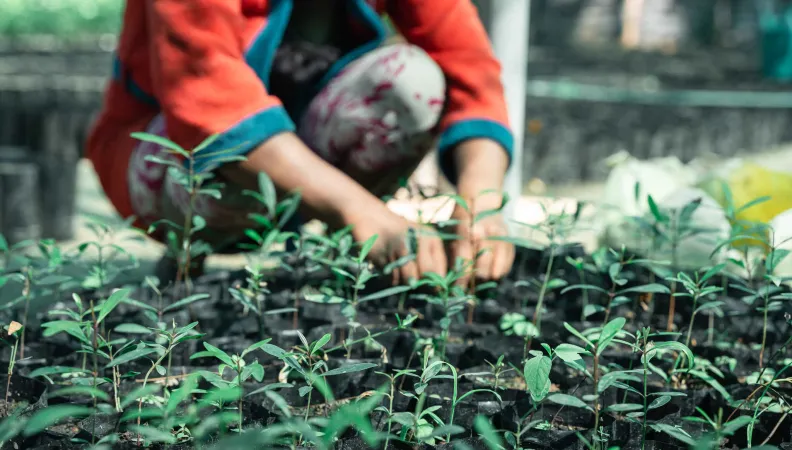 Legal notice EU (project) How can we measure the efforts made by developing countries to combat the inequalities and the impacts of climate change while taking into account the socioeconomic structure of these countries? The EU-AFD Research Facility on Inequalities will seek to answer this question in collaboration with the Ghanaian research think tank Placefeet.
Legal notice EU (project) How can we measure the efforts made by developing countries to combat the inequalities and the impacts of climate change while taking into account the socioeconomic structure of these countries? The EU-AFD Research Facility on Inequalities will seek to answer this question in collaboration with the Ghanaian research think tank Placefeet.
Context
Many of the measures on quantifying progress by countries towards reducing income inequality have focused on indices that measure trends in inequality over time (Gini coefficient for example) and compare countries without considering the differences between their socioeconomic structures.
However, these indices do not paint the complete picture about how countries are performing, especially when compared to one other in achieving Sustainable Development Goals and what policies and investments may be needed to support them. This research project will provide an alternative measurement of income inequality by taking into account the developing countries’ structural or predetermined conditions (mineral assets, type of institutions etc.) in assessing their progress towards reducing inequality and the impacts of climate change.
This project is part of the call for research proposals “Advancing the inequality agenda through collaborative research: identifying the priorities for a global Team Europe approach on inequalities”, launched by the Strategic Committee of the Research Facility on Inequalities. It is coordinated by AFD and co-financed by the European Commission, AECID and ENABEL.
Objectives
The project focuses on the following objectives:
- Firstly, it will compare each country with its potential to reduce income inequalities by measuring the scope for improvement for each country at every year. This will allow a better understanding of the key factors that hinder a country’s effort and performance in reducing inequalities and of the policy and investments that are needed to tackle inequalities more efficiently.
- Secondly, it will investigate how climate – temperature, precipitation and extreme weather events– influence the efficiency of countries in combining inputs to reduce inequality.
- Thirdly, it will look at adaptation or intensification effects across regions, particularly in LDCs and SIDS and will identify the needed scale of investments.
Method
Building on a panel database on 145 countries, including countries from Least Developed Countries (LDCs) and Small Island Developing States (SIDS) from 2000-2020, the project will use a stochastic frontier approach, an economic modelling technique, to estimate feasible frontiers for income inequality for each country and year.
Results
You will find below the different research papers related to this project:
 This research partnership with EcoAct has allowed to enrich the notion of "standard of good ecological condition", which is central to ESGAP (Environmental Sustainability Gap), a methodology supported by AFD to assess the environmental sustainability of a given territory. This work will help prepare the continuation of the ESGAP research programme.
This research partnership with EcoAct has allowed to enrich the notion of "standard of good ecological condition", which is central to ESGAP (Environmental Sustainability Gap), a methodology supported by AFD to assess the environmental sustainability of a given territory. This work will help prepare the continuation of the ESGAP research programme.
Context
Today, the majority of leaders acknowledge the degradation of natural capital and the urgent need to protect the environment. Nevertheless, in order to define appropriate public policies, they must be able to rely on scientific standards that allow them to assess the state of a territory’s natural capital.
It remains difficult to assess this state, or even to define exactly what a "good state" of the planet should be: most existing instruments have an incomplete definition of environmental sustainability, lack of relevant indicators or fail to set appropriate targets to achieve good environmental status. There is therefore no satisfactory approach that would allow decision-makers or experts to know whether a country is moving towards environmental sustainability.
Based on a dashboard assessing the state of 23 environmental components, the ESGAP framework aims to address this need. However, the lack of appropriate standards for many essential natural capital contributions and in many countries is one of the most notable gaps identified in the ESGAP pilot projects in New Caledonia, Kenya and Vietnam.
Watch the video: How to measure the state of the planet?
Goal
This research project with EcoAct aimed to identify missing standards for several components of the Environmental Sustainability Gap (ESGAP). It discusses possible strategies to develop appropriate standards in the event that no standards are available globally.
Method
ESGAP is an innovative tool initially developed with University College London (UCL) that assesses the state of a territory’s environmental functions and their level of sustainability. For all critical components of natural capital in the territory concerned (air or water quality, pollution, forest resources, fishing resources, etc.), this indicator calculates the difference between their current state and a state that would be sustainable (that is, a state compatible with a sustainable functioning of the processes necessary for the preservation of life, human activities and well-being). This allows the calculation of an “environmental sustainability gap” (ESGAP), which highlights the path to environmental sustainability. This can then serve as a guide for public policies to estimate and preserve the natural state of a given territory.
Results
Standards have been proposed for 16 out of the 22 ESGAP indicators examined in this research project. For 8 indicators, there was not enough solid information to propose a global standard. The study identified 13 datasets available to calculate these indicators globally and provided the source and link to these publicly available databases.
Read the final report: Defining Standards of Good Ecological Condition for Computing the ESGAP in Developing Countries
Lessons learned
The next step to produce a standard of good ecological condition applicable to all countries involves, for indicators with "standards to be defined by experts" (Fairbrass, 2020), to consider who the experts might be and how to engage with them to define a globally applicable standard. This depends on the existence of a globally recognized authority (such as the World Health Organization for pollution or the Food and Agriculture Organization for fisheries), or if the indicator is developed by different teams of scientists or organizations.
Future work could also focus on examining the state of knowledge and options for setting standards from unconventional sources, such as geospatial data, big earth data, etc. The ARIES project related to the compilation of ecosystem accounts under the System of Environmental-Economic Accounting – Ecosystem Accounting (SEEA-EA) could be an interesting source for this.
Find out more about ESGAP:
- A single indicator of strong sustainability for development: Theoretical basis and practical implementation (2019)
- Monitoring the Environmental Sustainability of Countries through the Strong Environmental Sustainability Index (2022)
- Are We on the Right Path? Measuring Progress towards Environmental Sustainability in European Countries (2022)
Contact:
- Oskar Lecuyer, research officer, AFD

